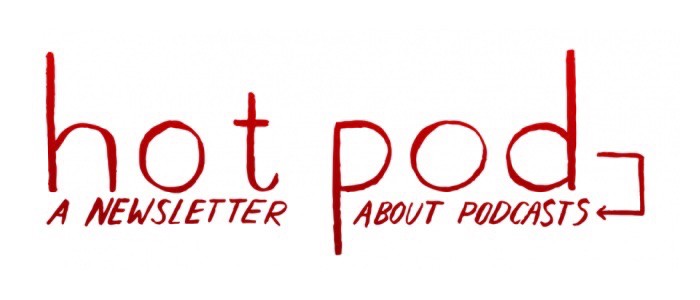
Welcome to Hot Pod, a newsletter about podcasts. This is Issue Forty-Four, published October 13, 2015.
Let’s talk about WNYC, shall we?
 WNYC announces its big podcast play. Spicy news from the biggest public radio station in America! The New York Times reported Monday that WNYC is breaking open a new podcast division this week that aims to put the station in a better position to properly duke it out in the growing podcast market. The division is called “WNYC Studios,” and you can see its logo on the new flashy hot pink Death, Sex, and Money podcast art on iTunes (all hail Anna Sale).
WNYC announces its big podcast play. Spicy news from the biggest public radio station in America! The New York Times reported Monday that WNYC is breaking open a new podcast division this week that aims to put the station in a better position to properly duke it out in the growing podcast market. The division is called “WNYC Studios,” and you can see its logo on the new flashy hot pink Death, Sex, and Money podcast art on iTunes (all hail Anna Sale).
I’m told that this hot pink version is not, um, permanent.
Anyway, the opening of this new division is best explained by a juice quote from WNYC chief content officer Dean Cappello: “This is the way we will become a much, much bigger content company, period.” An utterly glorious soundbite if I’ve ever heard one; I’m both surprised and enthused by a public radio executive’s embrace of the word “content.” We truly live in madness times. You simply must read the Times report in full, but here are a couple of highlights for me:
So this is all very exciting. But, in my mind, the real key to reading this development lies in this particular observation in the Times report: “Podcasts are also attractive to public broadcasters because they are not subject to the Federal Communications Commission’s strict rules about corporate sponsorship that govern the public airways.”
WNYC is a nonprofit public radio station, which informs both its content imperatives (namely, to serve the public interest, subjectively defined) and its potential sources of revenue (sponsorships/underwriting, grants, donations — anything but commercial advertising sales, which is expected to be the central driver of the podcast industry). It’s a common refrain that podcasts are the Wild West, so there’s an opportunity here for WNYC to skirt around the boundaries set by their public radio mandate; they could, if they wanted to, press hard and long with advertising-based revenue-generation plays, even if they stick with the “underwriting” language.
As someone said to me on Twitter yesterday, there are two central mysteries at hand: To what extent will WNYC Studios allow the station to raise money outside the traditional non-profit model? And is this part of a larger narrative that sees WNYC angling to enter a flexible relationship with its public broadcasting responsibilities? In my head, the mystery can be further summed up with a much broader question: What are the core incentives at play here?
I’m scheduled to chat with someone from the station sometime this week, so tune in next week for more.

Sideshow is over. A quick side-quest while we’re on the subject of WNYC: Sideshow, the culture-focused mini-pod that’s kind of like a growth jutting out the side of the Studio 360 program, is closing shop. It posted its final episode on Monday, and you can listen to it here.
However, this is not the end for Sideshow host Sean Rameswaram. He’s reportedly already locked in for another project, which he will apparently name “Fo Show.”
The Grantland exodus touches us all (but specifically, me). Per Deadspin’s coverage on the Great Disruption currently slamming the digital miracle known as Grantland, last Friday saw four staffers turn in their resignation in their intent to join Bill Simmons at some new venture. Those staffers include Chris Ryan, one half of the Hollywood Prospectus podcast, Juliet Litman, of the Right Reasons and Food News podcasts, and Mallory Rubin, who I absolutely loved as a correspondent on the Watch the Thrones podcast.
All those pods are probably dead. (In fact, I believe Andy Greenwald has tweeted out confirmation that the Hollywood Prospectus will no longer continue.) Between this and the end of the Do You Like Prince Movies? podcast due to Wesley Morris’ departure to The New York Times, it’s like the entire Grantland podcast universe crumbled in under a month.
There’s probably some larger lesson to draw from this — some banal observation about how podcasts are completely dependent on their personalities, or maybe something about how podcasts are so peripheral to larger media institutions. But I’ll let someone else make that because I’m just completely devastated; despite their very obvious technical flaws, I loved Grantland’s podcasts. They were raucous and fun and conversationally rich and so stupidly comforting. To have a sizable chunk of my pod diet wiped out in the span of a few weeks is truly painful, and I’m left a blubbering mess.
After sending this letter out, I’m going to straight to bed. Except I have to go to work. So I’ll go to work and then go back home straight to bed.

Hillary Pod-ham Clinton. In case you didn’t hear, Democratic presidential hopeful and former U.S. Secretary of State Hillary Clinton was on BuzzFeed’s Another Round this week. The interview is really something special, and I can’t recommend it highly enough. I reached out to the producers for comment about how they’re feeling right now.
Jenna Weiss-Berman, BuzzFeed’s head of audio: “If you’d told me six months ago, when we were airing our first show, that Hillary Clinton’s team would approach us about an interview, I would have told you you were outta your damn mind. It’s been such a great ride and I’m so proud of our BuzzFeed pod squad, especially Heben Nigatu, Tracy Clayton and genius editor Eleanor Kagan.”Eleanor Kagan, Another Round producer: “How I feel: Extremely proud of Heben and Tracy for being fearless interviewers, for asking hard questions and also hilarious questions. I hope people enjoy the interview and would like to add that we’ll take Secretary Clinton up on that rain check for a glass of bourbon any time.”
In other news, Weiss-Berman has been dropping hints of a major project that’s been in the pipeline for months now, and she’s suggested that the thing is due to drop next week. So watch out for that.
In other other news, President Obama followed up his Marc Maron interview with a spot on the New York Review of Books podcast, where he talked all manner of books. #PresidentialPods. It’s a thing, folks.
And speaking of folks, here’s one hour of Maron saying “Hey, folks” — an awesome-awful gem.
On diversity. Stephanie Foo is a force of nature. One of the original Snap Judgment producers, she’s a current This American Life producer who was partially responsible for last month’s great Audio Hackathon. Foo kicked October off with a fantastic Transom manifesto about how to get off your ass and diversify your goddamn workplace because it makes your organization stronger, it’s better for business, and it’s 2015 fer chrissakes. Just read it and get to work.

The P In NPR. I highly recommend you check out the latest Radio Diaries episode, which features host Joe Richman picking the brain of Bill Siemering, the man who wrote the original mission statement for National Public Radio in 1969 ahead of the organization’s launch in February 1970. It’s gorgeous, gorgeous stuff. Not specifically pod-related, but it’s always nice to think about where a lot of this came from, y’know?
Podcast marketing :: app marketing. So I’ve long bought into the notion that podcast discovery is broken, but truth be told, I’ve never been able to clearly visualize or articulate how podcast discovery is broken.
This past weekend I found a framework that perhaps brings me the closest to internalizing the core problem as a structure. Priya Ganapati, the current director of platform products at Quartz who previously led The Wall Street Journal’s mobile apps initiative, recently published Medium piece arguing the lack of strategic feasibility for small-to-mid-sized publishers getting into the news app game, and she made the following point:
New apps usually add a flurry of users when they launch and then after six months stall out in terms of growth or have growth in very low single digits. The most effective marketing strategy for a news app is “Get featured by Apple or Google on the app store.” The problem is Apple doesn’t make marketing commitments. So if getting featured on the app store happens, you probably got lucky. And that cannot be a business strategy. That leaves two options for customer acquisition: spend $$$ on an expensive ad campaign or pepper your website with banners asking readers to download your app. Neither is effective.
Smarter people have probably made this argument before, but the similarities between podcast marketing and app marketing in this regard was nothing less than revelatory — the very same dynamics are at play for businesses looking to make money of launching podcasts at scale using non-vanity/non-goosed metrics. To clarify and further the parallel, consider the following three factors anchoring the structural similarities between apps and podcasts:
Of course, here comes the Android caveat: I have very little understanding of how that side of the podcasting universe works, so if anybody is up to dispelling me of my ignorance, please, write me and let me know how things work in your neighborhood.
I’ve got no larger point to make just yet — or ever, come on — but Ganapati’s piece has been really helping me move along in my thought process about this whole hullaballoo.
Is this your first time reading Hot Pod? You can subscribe to the newsletter here, which mostly features irrelevant exclusive content (mostly different GIFs and stuff about what I had for lunch but whatever that’s the newsletter strategy I’m rolling with).
Nicholas Quah heads audience development at Panoply. Hot Pod is his weekly newsletter on the state of the podcast world; it appears on Nieman Lab on Tuesdays.